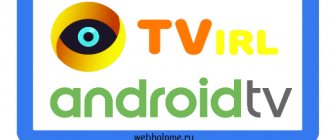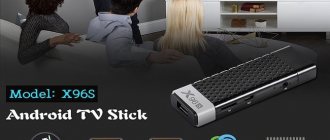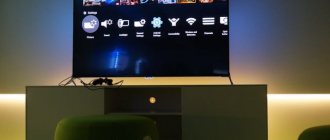The announcement of the new Chromecast showed that time is cyclical: the new streaming dongle runs Google TV. No, this is not a new platform based on Android TV. And this is not the same Android TV. The situation with this name change is truly confusing. But what you really can’t get confused about is that Chromecast with Google TV (that’s what the new model is officially called) has become, in fact, an improved version of Chromecast Ultra. The new product broadcasts 4K video, has a complete remote control and received several interesting functions from Google TV. Of course, the new platform is not perfect, but for $50 (the official price for the new product in the US) it’s hard to complain.
Telegram channel of the creator of Trashbox about technology
Characteristics
- Storage: 8 GB.
- Video: up to 4K at 60 FPS, Dolby Vision, HDR10, HDR10+.
- HDMI: 2.1.
- Audio: DTS, Dolby Digital+, Dolby Audio, Dolby Atmos.
- Wi-Fi: 802.11ac (2.4/5 GHz).
- Bluetooth: yes.
- Software: Google TV (Android 10).
- Dimensions and weight of the dongle: 162×61×12.5 mm, 55 grams.
- Dimensions and weight of the remote control: 122×38×18 mm, 63 grams.
- Remote control sensors and sensors: accelerometer, IR port, microphone.
What can he do?
The main task of Chromecast is to stream* content from a smartphone, tablet or laptop to a TV. And he copes with this very well.
You can, for example, look at the summer photos that are lying around in Google Photos. It's more convenient on a big screen. Or listen to the new album Panic! At the Disco on Google Music. And another Deadpool trailer has been released on YouTube, you should watch it this evening.
You can even switch to mirroring mode, and the TV will display everything that happens on the smartphone. It works tolerably, but the image quality is not particularly high.
It's better to use apps that support Chromecast. The picture there is excellent, and everything works as it should. There is Amediateka, Netflix. There are angry birds too, where would we be without them? Even photographs can be processed, but this is not the best idea, believe me.
Attention! You can stream from iOS devices ONLY through apps that support Chromecast; AirPlay is not supported.
* “Stream content” – that is, broadcast it from a device to a TV.
The home page consists of:
- Anycast connection to a wireless network
Additional Information
To start operating the device, it must be connected to a wireless network to which the control device is also connected (Android OS/Apple OS). To do this, go to the first point with the WIFI icon.
We have 2 controls, back and scanning for wireless networks.
Having found our network, we go to it. The device has an external WIFI antenna, so we have stable reception of wireless networks.
On the same screen we see the BSSID address of the router, transmission frequency and security level. Enter your network password and go to the treasured Connect
The final connection occurs after going to this screen and selecting confirmation of the wireless network.
- Anycast translation between Miracast/DLNA standards
Additional Information
I still don’t understand what happens in the device after activating this mode. Perhaps different standards are used on android/ios and this item is just for that.
- go to media control buttons
Additional Information
- Anycast settings
Additional Information
Here we have the opportunity to change the start password, which will work after restarting the device and something with a changing value called overscan
After completing the settings, the name of the connected wireless network appears on the monitor with the device’s home page, in my case it is
Mashuk_WiFi.
What's new
In September last year, Google introduced the second generation of Chromecast. Outwardly, it has nothing in common with the first one, it resembles a large Chrome icon.
There are three colors: black, red and yellow. However, what difference does it make, it will still hang out behind the TV.
What is the difference with the old Chromecast:
1. The new one is much faster than the previous model. And all because there are more powerful Wi-Fi antennas and filling inside. Now a dual-band 2.4 or 5 GHz 802.11ac Wi-Fi connection is used, plus an “adaptive antenna”.
2. The new one supports more applications. The list is extensive, there is Amediateka and NTV. I even found Odnoklassniki, well, it’s necessary.
3. Updated software. Along with the device, the application of the same name has also improved. It has become prettier and much more useful. This is a single center that combines all software for Chromecast. The idea is good, everyone can manage from one place.
4. You can play games and use programs. The smartphone is now both a remote control and a gamepad. Although the gamepad, of course, is a strong word. You can, for example, use it as a slingshot for Angry Birds. Chromecast also learned to be friends with Google Photos. You can show and simply watch your photos on a huge TV screen.
5. Videos load quickly. With the Fast Play you can forget about buffering. The video has not yet been turned on, but the first few seconds have already been loaded. Down with the waiting and the annoying loading wheel.
In general, Chromecast 2 has definitely become more useful than the previous generation. Therefore, I confidently advise you to upgrade from the first one .
Models to Consider
As you may have noticed, the benefits offered by Smart TVs with Chromecast are remarkable, so we recommend that you choose an Android TV model that has this feature. For this reason, don't miss our selection with ten quality models that will more than meet your expectations, and also integrate this media player for the most convenient mirroring of your phone's screen.
Philips 65Oled934/12
Let's start this selection with one of the crown jewels from the Dutch manufacturer. We're talking about the impressive Philips 65Oled934 / 12, a Smart TV that offers minimalist bezels so that its 65-inch OLED panel is the protagonist of your living room.
To this we must add a powerful soundbar signed by the renowned manufacturer Bower & Wilkins without any doubt to enjoy the acoustic landscape.
Sony OLED TV KD48A9
In second place is one of Sony's greatest gems within its television division. And the model has a 48-inch OLED panel, so it's ideal for small spaces, and the picture quality won't disappoint you at all.
Philips 65OLED855/12
We already expect that you will see several Philips models in this selection. And that's simply because it has one of the most powerful catalogs when it comes to choosing Smart TVs with Android TV and Chromecast. The Philips 65OLED855/12 will more than meet your expectations and will also have Alexa support.
Sony KD-77AG9 Master series
Another great option is the Sony KD-77AG9 Master Series. A smart TV that exudes quality from every pore, betting on a very well-balanced OLED panel and supported by the Japanese firm's Triluminos technology to offer a visual landscape beyond any doubt.
Philips 55OLED804/12
The last model with an OLED panel that we want to recommend to you is the Philips 55OLED804/12. A smart TV with minimal bezels so that the 55-inch screen looks like never before, in addition to the P5 Perfect Picture Engine for the best results.
TCL 65DC762
In a compilation of this type, the sensational TCL 65DC762 could not be ignored. A 4K Smart TV that works with Android TV and surprises by offering amazing sound thanks to a speaker signed by JBL.
Philips Ambilight 65PUS7354
The last Philips TV we'd like to recommend is a 65-inch 4K model. Smart TV with Ambilight technology for a truly immersive experience. There is no doubt that if you try this technology, you will not want a model without this feature.
TCL 75EP680
Continuing with this compilation of the best TVs with Chromecast built-in, we didn't want to miss the opportunity to recommend the TCL 75EP680. Smart TV with Android TV, 75-inch screen and great price.
Sony KD-65XG8577
Another model that will not disappoint you at all is the Sony Android TV. A model that stands out because it offers object-based HDR remaster technology to achieve impeccable image quality.
Price situation: where is it cheaper?
The console officially costs $35 . At the current exchange rate this is 2,695 rubles. But getting it is not so easy.
Can be ordered from America. Theoretically, it's cheaper there. Amazon does not sell it, there is only an option offsite, Google Store.
Feel free to add another $25 for delivery using third-party services, plus a wait of a month and a half. As a result, it’s not much cheaper overseas, but delivery costs and time cover the entire difference.
In Russia, Chromecast 2 is already available for 4,869 rubles . Why wait and save three pennies when everything is already in stock and with fast delivery?
History of Chromecast predecessors
Google managed to create a good, modern and inexpensive media player for watching high-definition video only the third time. The first attempt to conquer the market was the Google TV project. But the company's package of services included only software applications, and the predecessor devices of the chromecast had to be produced by partners involved in hardware development. Naturally, Google was not at all going to ignore the hard drive market, and the company’s second attempt to conquer it was the development of the Nexus Q device. But a market review showed that a set-top box priced at $299 was beyond the means of most users. The third attempt to successfully enter the set-top box market was the Google Chromecast device, compact and inexpensive.
How it works
Everything is elementary:
1. We connect Chromecast via HDMI to the TV.
2. On the other hand, the gadget must be connected either to an outlet or directly to USB on the TV. This is power supply, and both options are possible, since not every TV can provide the required voltage.
3. Next, we establish a connection between the gadget and Chromecast. To do this, download the application from the App Store or Google Play, and then follow the instructions on the screen.
4. OK it's all over Now. Basically, the main thing is to connect to Wi-Fi and connect both devices.
Casting using Chromecast and Miracast: related technologies
Of course, all wireless streaming devices have differences, including supported applications, protocols, resolutions, software, frame rates, and so on.
For example, Miracast does not need an Internet connection, and Chromecast cannot work offline because the protocol is based on network access. In addition, Miracast blocks the use of a smartphone for other purposes, and Chromecast can be positioned as a streaming media center. During its activation, a person can safely use his gadget.
Main characteristics:
- The Miracast processor runs at 600 MHz, AnyCast uses the same single-core 1.2 GHz Cortex-A9 processor, Chromecast has a dual ARM Cortex-A7 based 1.2 GHz processor.
- MiraCast uses 128 MB of RAM, AnyCast - 256 MB, Chromecast - 512 MB;
- Wi-Fi signal MiraCast – 450 megabits per second, AnyCast – megabits per second.
Remote control similar
Here we find a huge similarity between both commands and that is that the Siri Remote, which Apple calls its command, is very similar to the Google Chromecast command. Or maybe we should say it backwards because the Apple TV is coming first. In any case, both are functional and fully adapted to its interface.
In the case of the Siri Remote, it's always been accused of being unintuitive, although at the end of the day it caters to everyone's tastes and once its learning curve is overcome, it's extremely easy to use. On some TVs, it can even serve as the primary control for changing volume or switching between TV channels when you're not in the tvOS interface. If you lose your remote, keep in mind that the Apple TV control feature comes standard on iPhone and iPad and has a similar appearance to the remote itself.
As we've already noted, Chromecast also integrates its own control, and while it has similarities, it ends up being more comprehensive than the Apple TV since it has different direct access buttons. This means that in addition to being able to navigate and launch different apps, you can also quickly access apps like YouTube or Netflix. It also has a shortcut to mute the sound or return to the main menu to change the content you're watching.











